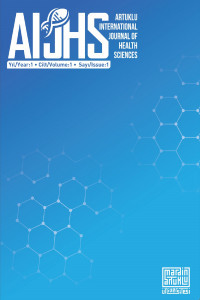Medulla Spinalis Yaralanmalarında Nörorejen İskele Uygulamaları
Kolajen, Nörorejen iskeleler, Spinal kord yaralanması
Neuroregen Scaffolding Applications in Medulla Spinalis Injuries
Collagen, Neuroregen scaffolds, Spinal cord injury,
___
- Adigun OO, Reddy V, Varacallo M. Anatomy, back, spinal cord. In: StatPearls (Internet). Treasure Island (FL): StatPearls Publishing 2019.
- De Leener B, Taso M, Cohen-Adad J, Callot V. Segmentation of the human spinal cord. Magnetic Resonance Materials in Physics, Biology and Medicine. 2016;29(2):125-53.
- Dumont RJ, Okonkwo DO, Verma S, Hurlbert RJ, Boulos PT, Ellegala DB, et al. Acute spinal cord injury, part I: Pathophysiologic mechanisms. Clinical neuropharmacology. 2001;24(5):254-64.
- Bennett J, Emmady P. Spinal Cord Injuries. In: StatPearls (Internet). Treasure Island (FL): StatPearls Publishing 2020.
- McDonald JW, Sadowsky C. Spinal-cord injury. The Lancet. 2002;359(9304):417-25.
- Lin H, Chen B, Wang B, Zhao Y, Sun W, Dai J. Novel nerve guidance material prepared from bovine aponeurosis. Journal of Biomedical Materials Research Part A: An Official Journal of The Society for Biomaterials, The Japanese Society for Biomaterials, and The Australian Society for Biomaterials and the Korean Society for Biomaterials. 2006;79(3):591-8.
- Li Y, Liu Y, Li R, Bai H, Zhu Z, Zhu L, et al. Collagen-based biomaterials for bone tissue engineering. Materials & Design. 2021;210(110049):1-23.
- Tang F, Tang J, Zhao Y, Zhang J, Xiao Z, Chen B, et al. Long-term clinical observation of patients with acute and chronic complete spinal cord injury after transplantation of NeuroRegen scaffold. Science China Life Sciences. 2022;65(5):909-26.
- Chen W, Zhang Y, Yang S, Sun J, Qiu H, Hu X, et al. NeuroRegen scaffolds combined with autologous bone marrow mononuclear cells for the repair of acute complete spinal cord injury: a 3-year clinical study. Cell Transplantation. 2020;29(0963689720950637):1-11.
- Han S, Xiao Z, Li X, Zhao H, Wang B, Qiu Z, et al. Human placenta-derived mesenchymal stem cells loaded on linear ordered collagen scaffold improves functional recovery after completely transected spinal cord injury in canine. Science China Life Sciences. 2018;61(1):2-13.
- Yeong WY, Chua CK, Leong KF, Chandrasekaran M, Lee MW. Indirect fabrication of collagen scaffold based on inkjet printing technique. Rapid Prototyping Journal. 2006.
- Nocera AD, Comín R, Salvatierra NA, Cid MP. Development of 3D printed fibrillar collagen scaffold for tissue engineering. Biomedical Microdevices. 2018;20(2):1-13.
- Xiao Z, Tang F, Zhao Y, Han G, Yin N, Li X, et al. Significant improvement of acute complete spinal cord injury patients diagnosed by a combined criteria implanted with NeuroRegen scaffolds and mesenchymal stem cells. Cell Transplantation. 2018;27(6):907-15.
- Zhao Y, Tang F, Xiao Z, Han G, Wang N, Yin N, et al. Clinical study of NeuroRegen scaffold combined with human mesenchymal stem cells for the repair of chronic complete spinal cord injury. Cell transplantation. 2017;26(5):891-900.
- Li X, Xiao Z, Han J, Chen L, Xiao H, Ma F, et al. Promotion of neuronal differentiation of neural progenitor cells by using EGFR antibody functionalized collagen scaffolds for spinal cord injury repair. Biomaterials. 2013;34(21):5107-16.
- Hatami M, Mehrjardi NZ, Kiani S, Hemmesi K, Azizi H, Shahverdi A, et al. Human embryonic stem cell-derived neural precursor transplants in collagen scaffolds promote recovery in injured rat spinal cord. Cytotherapy. 2009;11(5):618-30.
- Breen BA, Kraskiewicz H, Ronan R, Kshiragar A, Patar A, Sargeant T, et al. Therapeutic effect of neurotrophin-3 treatment in an injectable collagen scaffold following rat spinal cord hemisection injury. ACS Biomaterials Science & Engineering. 2017;3(7):1287-95.
- Peng Z, Gao W, Yue B, Jiang J, Gu Y, Dai J, et al. Promotion of neurological recovery in rat spinal cord injury by mesenchymal stem cells loaded on nerve-guided collagen scaffold through increasing alternatively activated macrophage polarization. J Tissue Eng Regen Med. 2018;12(3):e1725-e36.
- Shi Q, Gao W, Han X, Zhu X, Sun J, Xie F, et al. Collagen scaffolds modified with collagen-binding bFGF promotes the neural regeneration in a rat hemisected spinal cord injury model. Sci China Life Sci. 2014;57(2):232-40.
- Han Q, Sun W, Lin H, Zhao W, Gao Y, Zhao Y, et al. Linear ordered collagen scaffolds loaded with collagen-binding brain-derived neurotrophic factor improve the recovery of spinal cord injury in rats. Tissue Engineering Part A. 2009;15(10):2927-35.
- Han S, Wang B, Jin W, Xiao Z, Li X, Ding W, et al. The linear-ordered collagen scaffold-BDNF complex significantly promotes functional recovery after completely transected spinal cord injury in canine. Biomaterials. 2015;41(2015-02-01):89-96.
- Başlangıç: 2021
- Yayıncı: Mardin Artuklu Üniversitesi
Ulipristal Asetatın Ratlarda Oluşturulan Cerrahi Endometriozise Etkisi
Mehmet Nuri DURAN, Hacı Öztürk ŞAHİN, Nihal KILINÇ, Bülent DEMİR
Serhat GÜNLÜ, Mehmet Zülkif KARAHAN
Diminutif ve Küçük Kolorektal Poliplerde Kanser Riskinin Değerlendirilmesi
Yağmur YILMAZ, Birgül KANDEMİR, Şeymanur GÖKÇE, Tuğba ERGÜL, Mahmut DAĞCI
Maksillofasiyal Travma ve Zor Havayolu Yönetimi: İki Olgu Sunumu
Enes ÇELİK, Mustafa BIÇAK, Hakan AKELMA
Gebelerin COVID-19 Korku Düzeylerinin Aşı Tutumlarına Etkisi
Ebru SOLMAZ, Emine Serap ÇAĞAN, Rumeysa TAŞKIN
Bir Üniversite Hastanesinde Sözel İstem Alma Süreci, Kontrolü ve Sonuçlarının Değerlendirilmesi
Tuğba MERT, Yasemen ÖZKAN, Muhsine ARSLAN, Aynur YÜCEL
Medulla Spinalis Yaralanmalarında Nörorejen İskele Uygulamaları
